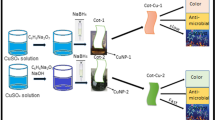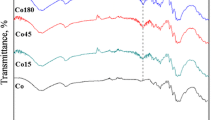Abstract
Nano-Cu2O particles were synthesized on cotton fabric using CuSO4 as a precursor and glucose as a reducing and cap** agent in alkali. The morphology, crystal phase and chemical structure of the fabrics were characterized by scanning electron microscope, X-ray diffraction, Fourier transform infrared spectroscopy and energy-dispersive X-ray spectroscopy. The colorimetric values of the treated fabrics were also measured using reflectance spectra. The treated fabrics showed significant photocatalytic activity toward the degradation of methylene blue under daylight. Excellent antibacterial activity of the treated samples against Staphylococcus aureus and Escherichia coli was also confirmed. Moreover, treated fabrics were proven to have no adverse effects (low toxicity) on human dermal fibroblasts based on the MTT test. Findings suggested the potential of the proposed method in producing a fabric with high antibacterial efficiency, excellent self-cleaning properties, faster wetting time and negligible color change. Bleached cotton fabric treated with 0.02 w/w% copper sulfate and 0.35 w/w% glucose in alkali media (0.35 w/w% sodium hydroxide) at 70 °C for 1 h was found to be the optimum sample, with many applications in various fields including clothing, medical clothing and bedding.









Similar content being viewed by others
References
Abboud Y, Saffaj T, Chagraoui A, El Bouari A, Brouzi K, Tanane O, Ihssane B (2013) Biosynthesis, characterization and antimicrobial activity of copper oxide nanoparticles (CONPs) produced using brown alga extract (Bifurcaria bifurcata). Appl Nanosci 4:571–576
Aladpoosh R, Montazer M, Samadi N (2014) In situ green synthesis of silver nanoparticles on cotton fabric using Seidlitzia rosmarinus ashes. Cellulose 21:3755–3766
Allahyarzadeh V, Montazer M, Hemmati Nejad N, Samadi N (2013) In situ synthesis of nano silver on polyester using NaOH/nano TiO2. J Appl Polym Sci 129:892–900
Anyaogu K, Fedorov A, Neckers D (2008) Synthesis, characterization, and antifouling potential of functionalized copper nanoparticles. Langmuir 24:4340–4346
Behzadnia A, Montazer M, Rashidi A, Mahmoudi Rad M (2014) Sonosynthesis of nano TiO2 on wool using titanium isopropoxide or butoxide in acidic media producing multifunctional fabric. Ultrason Sonochem 21:1815–1826
Chen LQ, Kang B, Ling J (2013) Cytotoxicity of cuprous oxide nanoparticles to fish blood cells: hemolysis and internalization. J Nanopart Res 15(3). doi:10.1007/s11051-013-1507-7
Courrol LC, Oliveira Silva FR, de Gomes L (2007) A simple method to synthesize silver nanoparticles by photo-reduction. Colloids Surf A 305:54–57
Dang TMD, Le TTT, Fribourg-Blanc E, Dang MC (2011) Synthesis and optical properties of copper nanoparticles prepared by a chemical reduction method. Adv Nat Sci 2:015009
Dastjerdi R, Montazer M, Shahsavan Sh (2009) A new method to stabilize nanoparticles on textile surfaces. Colloids Surf A 345:202–210
Dastjerdi R, Montazer M, Shahsavan Sh (2010) A novel technique for producing durable multifunctional textiles using nanocomposite coating. Colloids Surf B 81:32–41
De Jong WH, Borm PJ (2008) Drug delivery and nanoparticles: applications and hazards. Int J Nanomed 3:133–149
Deng X, Zhang Q, Zhao Q, Ma L, Ding M, Xu X (2015) Effects of architectures and H2O2 addition on the photocatalytic performance of hierarchical Cu2O nanostructures. Nanoscale Res Lett 10:8–17
Ghule K, Ghule AV, Chen BJ, Ling YC (2006) Preparation and characterization of ZnO nanoparticles coated paper and its antibacterial activity study. Green Chem 8:1034–1041
Gopalakrishnan K, Ramesh C, Ragunathan V, Thamilselvan M (2012) Antibacterial activity of Cu2O nanoparticles on E. coli synthesized from tridaxprocumbens leaf extract and surface coating with polyaniline. Dig J Nanomater Bios 7:833–839
Harifi T, Montazer M (2012) Past, present and future prospects of cotton cross-linking: new insight into nanoparticles. Carbohydr Polym 88:1125–1140
Harifi T, Montazer M (2014) Fe3+:Ag/TiO2 nanocomposite: synthesis, characterization and photocatalytic activity under UV and visible light irradiation. Appl Catal A 473:104–115
Hrenovic J, Milenkovic J, Daneu N, Kepcija R, Rajic N (2012) Antimicrobial activity of metal oxide nanoparticles supported onto natural clinoptilolite. Chemosphere 88:1103–1107
Kangwansupamonkon W, Lauruengtana V, Surassmo S, Ruktanonchai U (2009) Antibacterial effect of apatite-coated titanium dioxide for textiles applications. Nanomed Nanotech Biol Med 5:240–249
Karlsson HL, Cronholm P, Gustafsson J, Möller L (2008) Copper oxide nanoparticles are highly toxic: a comparison between metal oxide nanoparticles and carbon nanotubes. Chem Res Toxicol 21(9):1726–1732
Karlsson HL, Gustafsson J, Cronholm P, Möller L (2009) Size-dependent toxicity of metal oxide particles—a comparison between nano- and micrometer size. Toxicol Lett 188(2):112–118
Kim J, Kwon S, Ostler E (2009) Antimicrobial effect of silver-impregnated cellulose: potential for antimicrobial therapy. J Biol Eng 3:1–9
Komeili-Nia Z, Montazer M, Latifi M (2013) Synthesis of nano copper/nylon composite using ascorbic acid and CTAB. Colloids Surf A 439:167–175
Lazary A, Weinberg I, Vatine JJ, Jefidoff A, Bardenstein R, Borkow G, Ohana N (2014) Reduction of healthcare-associated infections in a long-term care brain injury ward by replacing regular linens with biocidal copper oxide impregnated linens. Int J Infect Dis 24:23–29
Li Y, Liang J, Tao Z, Chen J (2008) CuO particles and plates: synthesis and gas-sensor application. Mater Res Bull 43:2380–2385
Longano D, Ditaranto N, Sabbatini L, Torsi L, Cioffi N (2012) Synthesis and antimicrobial activity of copper nanomaterials. In: Cioffi N, Rai M (eds) Nano-antimicrobials: progress and prospects, Chapter 3. Springer, New York, pp 85–117
Montazer M, Pakdel E (2011) Functionality of nano titanium dioxide on textiles with future aspects: focus on wool. J Photochem Photobiol C: Photochem Rev 12:293–303
Montazer M, Nazari A, Moghadam MB, Anary-Abbasinejad M (2010) Self-cleaning properties of bleached and cationized cotton using nano TiO2: a statistical approach. Carbohydr Polym 83:1119–1127
Montazer M, Alimohammadi F, Shamei A, Rahimi M (2012a) Durable antibacterial and cross-linking cotton with colloidal silver nanoparticles and butane tetracarboxylic acid without yellowing. Colloids Surf B 89:196–202
Montazer M, Alimohammadi F, Shamei A, Rahimi M (2012b) In situ synthesis of nano silver on cotton using Tollens’ reagent. Carbohydr Polym 87:1706–1712
Nobumasa H, Hirofusa Sh, Sadao H (2007) Complex formation between poly(vinyl alcohol) and metallic ions in aqueous solution. J Polym Sci 47:299–307
Pawar MJ, Chaure SS (2009) Synthesis of CdS nanoparticles using glucose as a cap** agent. Chalcogenide Lett 6:689–693
Pena MMO, Koch KA, Thiele DJ (1998) Dynamic regulation of copper uptake and detoxification genes in Saccharomyces cerevisiae. Mol Cell Biol 18:2514–2523
Prabhu S, Poulose EK (2012) Silver nanoparticles: mechanism of antimicrobial action, synthesis, medical applications, and toxicity effects. Int Nano Lett 2:32–41
Rahman A, Ismail A, Jumbianti D, Magdalena S, Sudrajat H (2009) Synthesis of copper oxide nano particles by using Phormidium cyanobacterium. Indo J Chem 9(3):355–360
Ravindra S, Mohan YM, Reddy NN, Raju KM (2010) Fabrication of antibacterial cotton fibers loaded with silver nanoparticles via ‘‘Green Approach’’. Colloids Surf A 367:31–40
Salavati-Niasari M, Davar F (2009) Synthesis of copper and copper (I) oxide nanoparticles by thermal decomposition of a new precursor. Mater Lett 63:441–443
Sedighi A, Montazer M, Hemmatinejad N (2014a) Copper nanoparticles on bleached cotton fabric: in situ synthesis and characterization. Cellulose 21:2119–2132
Sedighi A, Montazer M, Samadi N (2014b) Synthesis of nano Cu2O on cotton: morphological, physical, biological and optical sensing characterizations. Carbohydr Polym 110:489–498
Yan C, Yue-jun W, Kang-gen ZH, Zhen B (2010) Morphology control of ultrafine cuprous oxide powder and its growth mechanism. Trans Nanferrous Met Soc China 20:216–220
Yang Z, Chen S, Hu W, Yin N, Zhang W, **ang C et al (2012) Flexible luminescent CdSe/bacterial cellulose nanocomposite membranes. Carbohydr Polym 88:173–178
Zhang Y, Deng B, Zhang T, Gao D, Xu A-W (2010) Shape effects of Cu2O polyhedral microcrystals on photocatalytic activity. J Phys Chem C 114:5073–5079
Zheng Zh, Huang B, Wang Z, Guo M, Qin X, Zhang X, Wang P, Dai Y (2009) Crystal faces of Cu2O and their stabilities in photocatalytic reactions. J Phys Chem C 113:14448–14453
Author information
Authors and Affiliations
Corresponding author
Ethics declarations
Conflict of interest
The authors declare that they have no conflict of interest.
Rights and permissions
About this article
Cite this article
Montazer, M., Dastjerdi, M., Azdaloo, M. et al. Simultaneous synthesis and fabrication of nano Cu2O on cellulosic fabric using copper sulfate and glucose in alkali media producing safe bio- and photoactive textiles without color change. Cellulose 22, 4049–4064 (2015). https://doi.org/10.1007/s10570-015-0764-2
Received:
Accepted:
Published:
Issue Date:
DOI: https://doi.org/10.1007/s10570-015-0764-2




